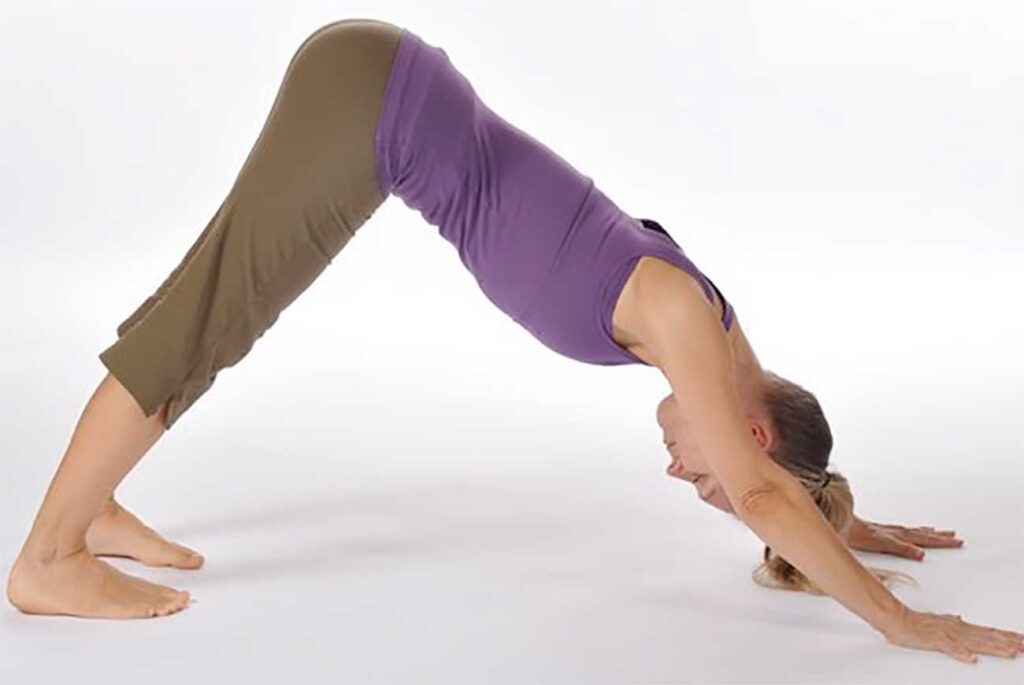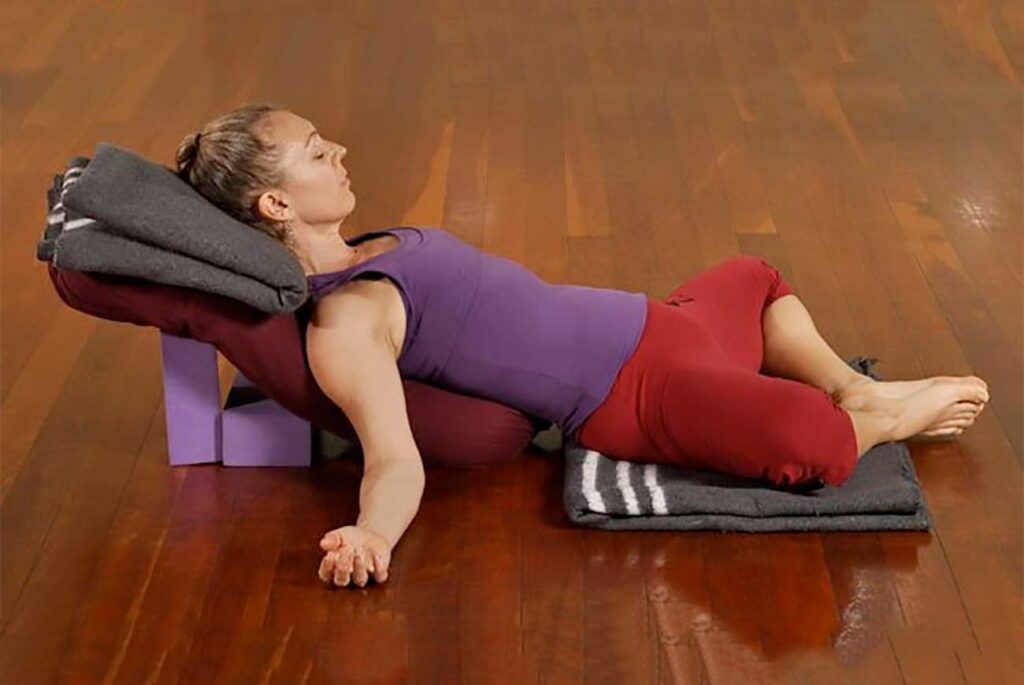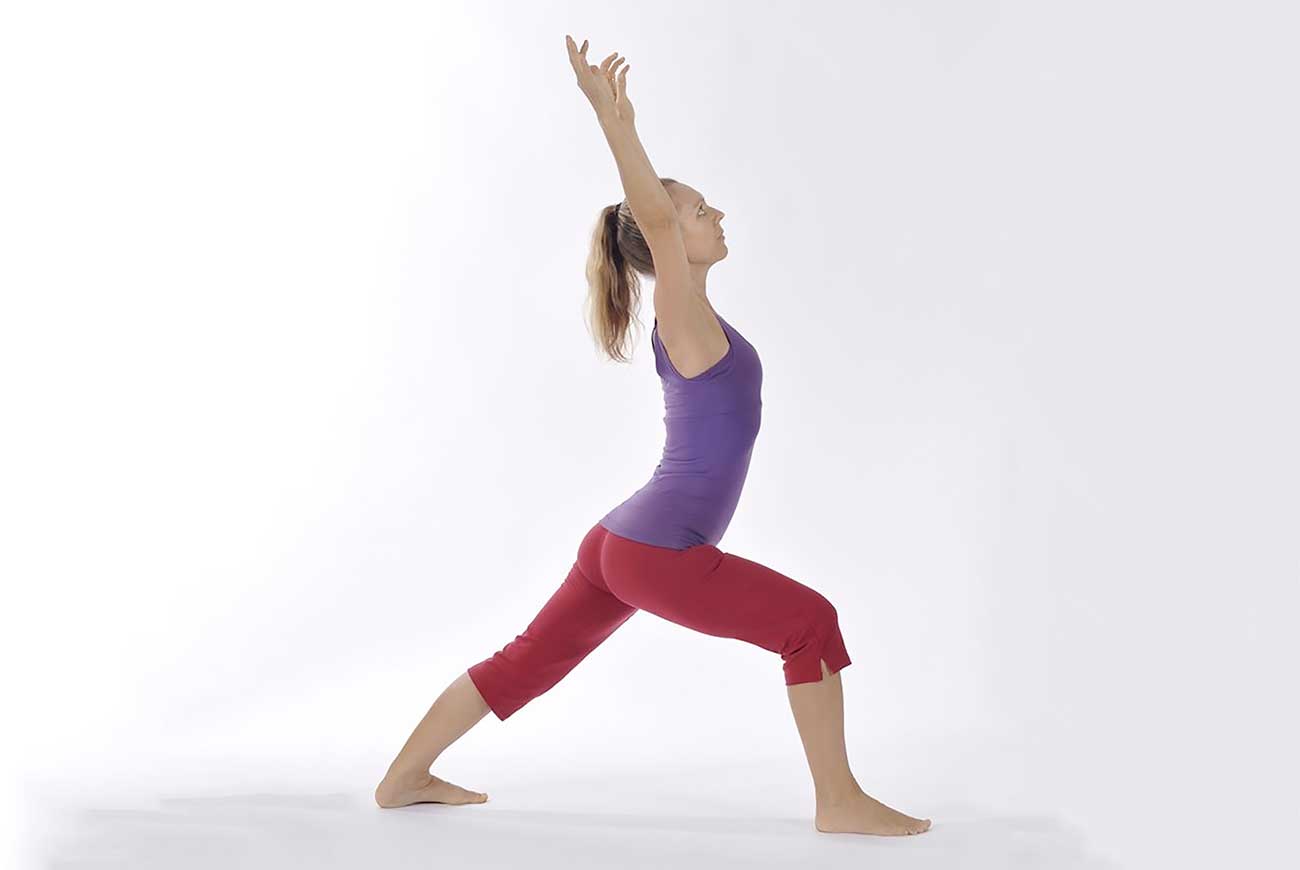This article is reproduced here by kind permission of Australian Yoga LIFE Magazine. It first appeared in issue 44.
Power of the Breath Vinyasa
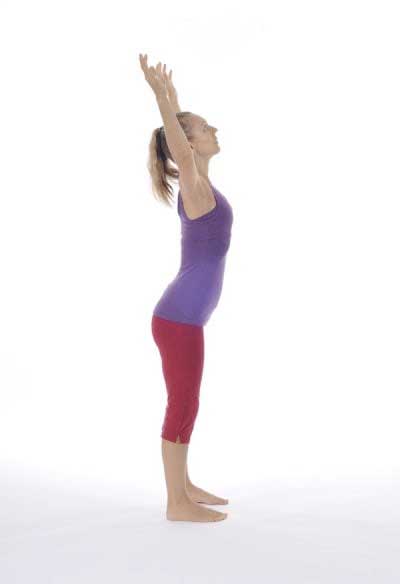
1. Begin by standing with the feet shoulder width apart. Inhale and raise the arms so that the chest opens.
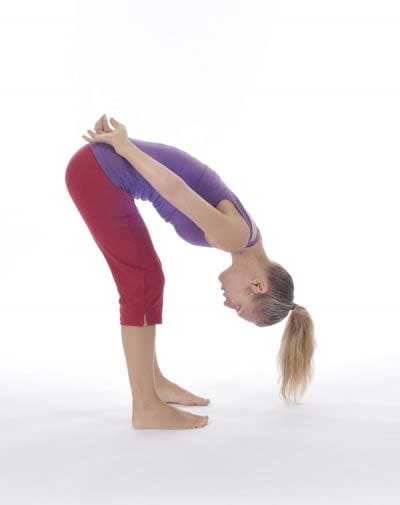
2. Chant Om as you fold at the hips. Let the knees be soft and rest the backs of the hands on the back of the hips. Repeat steps one and two six times.
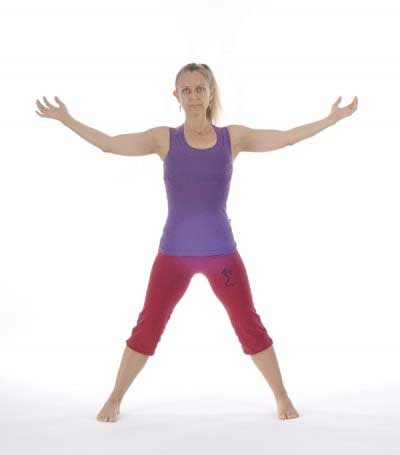
3. Step the feet to leg-length apart. Inhale as you open the arms wide apart so that the chest opens.
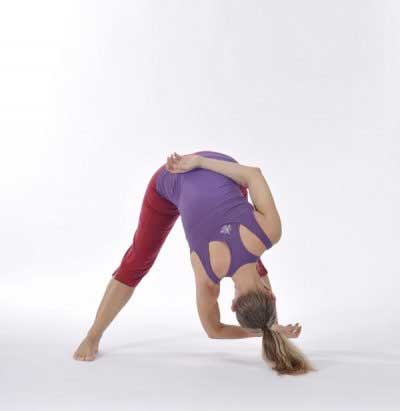
4. Exhale as you twist gently over the right leg. Rest the back of the right hand on the back of the hips. Let the head drop.
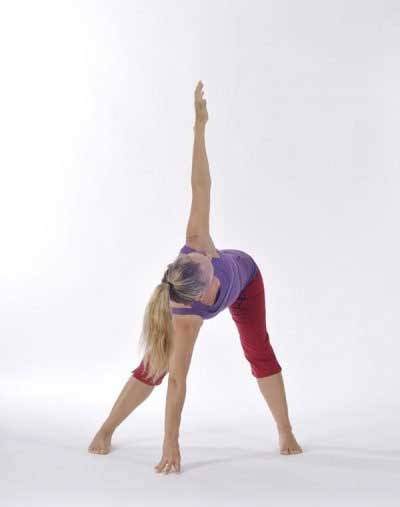
5. Inhale as you place the left hand to the floor, or on a block, so that the spine is parallel to the floor, and is central between the two legs. Raise the right arm, and HOLD the breath in at the top for a count of two.
Exhale return to pic 4.
Inhale return to pic 3.
Repeat 4 and 5 over the left leg.
This is one round-practice 3 rounds.
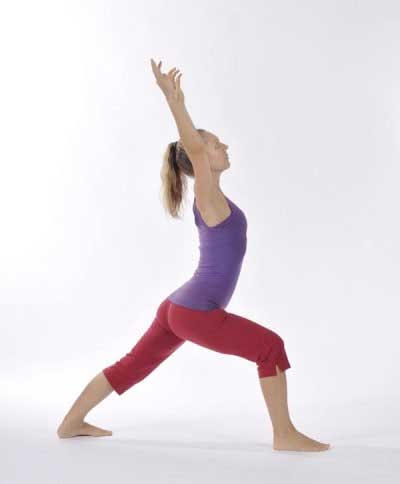
6. Step back to the front of the mat. Step the left foot back and a little to the left. Turn the left foot out to 45 degrees. The front of the hips are parallel to the front of the mat. Inhale as you raise the arms and bend the right knee. Open the chest.
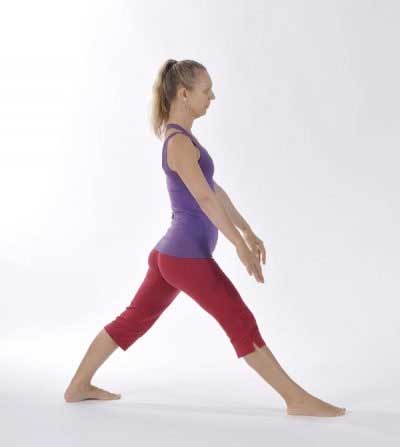
7. Exhale as you straighten the knee and let the arms float back down.
Repeat 7-8 six times. Then change sides.
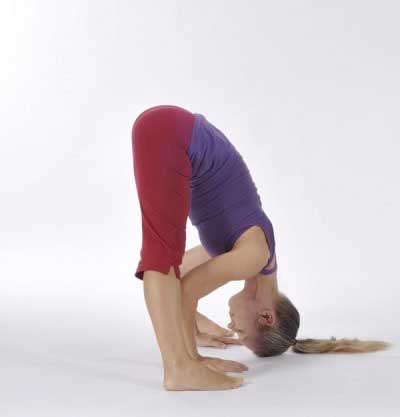
8. Repeat step 3.
As you exhale fold forward at the hips. Take the hands either to the legs or the floor, wherever you can comfortably reach.
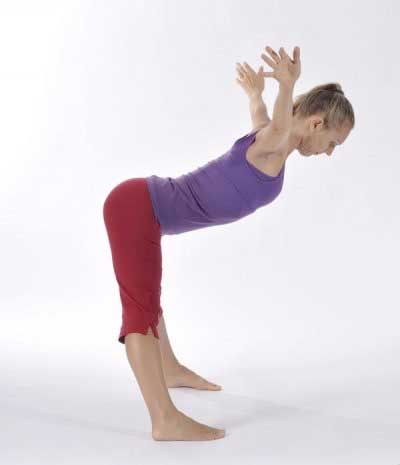
9. As you inhale, take the arms out wide and lift the torso up to half way. Try to hollow the back. Hold the breath in for two counts.
Exhale back to step 9. Repeat 9-10 six times.
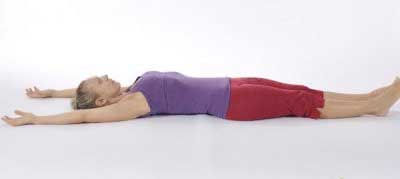
10. Lie down and rest for 2 minutes.
Then, stretch out on the mat, arms down beside the body. Inhale as you raise the arms all the way to the floor.
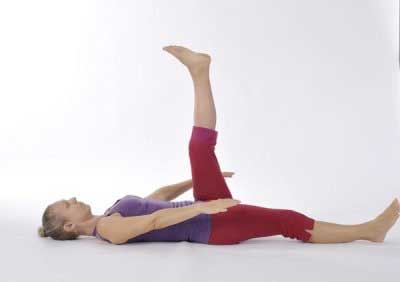
11. As you exhale, lift the right leg, lower the arms to the floor, and chant ‘Om’
(The lower back should not change shape as you lift and lower the leg. If you need to modify, bend the knee of the working leg.)
Repeat 11-12 six times. Then repeat for the left leg. (OR if you are strong, perform 12 x with both legs together.)
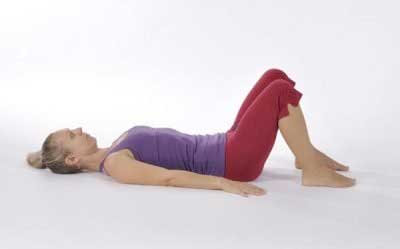
12. Bend the knees, and take the feet to hip width, heels beneath the knees.
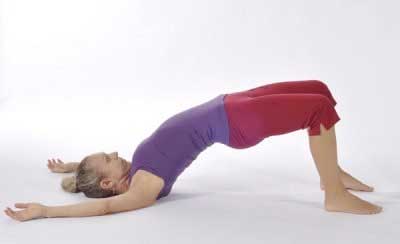
13. Inhale as you raise the arms and hips simultaneously. Exhale return to stage 13.
This is one round. Practice six rounds.
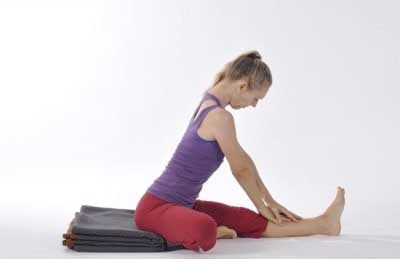
14. Come to sitting in the position shown. With the left leg straight, place the right palm onto the left thigh, and left palm on top. The back should be slightly concave, chin tilted inwards.
This is Maha Mudra. Begin to lengthen the breath and move into a subtle Ujjayi. Practice 6 rounds of breath with the following ratios:
*IN AK EX BK
4:0:F: 0 x 2
6:3: F:0 x 2
6: 6: F:0 x 2
Then change sides.
Numbers indicate time in seconds. F= a ‘free’ breath, with no count.
IN=Inhalation
AK=Inhale hold
EX=Exhalation
BK= Exhale hold
What has breath got to do with Asana?
I realised recently, when talking to the editor of this magazine, that I am mostly known for writing articles on bio-mechanics, and ‘fine-tuning’ in asana. Though these things are definitely passions of mine, it may not be apparent from those articles, that my real passion is breath! Combining breath and asana lifts the practice to a whole other level. In fact, all the refinements we can make to alignment and ?technique? in our asana practice are really meaningless unless there is also a smooth and consistent, conscious breath! In other words, it is more important that the breath is there than that the outward look of the posture is perfect! Here’s why.
Most yoga practitioners know, at least in theory, that the breath is used during pranayama to create particular effects on the energy body, and thus on the mind or mental state. But pranayama is not just something that can be used during a static sitting or supine practice – or that perhaps only intermediate or advanced students can achieve! We can all enhance our asana practice, and it?s benefits on all levels, by combining it with awareness of the breath!
In the Yoga Sutras of Patanjali, (the 2-5000 year old text that is often referenced as the ultimate classical text describing the methods, goals, and benefits of the yoga path).
Patanjali lists both asana (the physical postures) and pranayama (literally ‘the expansion of the dimension of prana-the life force’) as two separate steps in an eight step path, the totality of which is called ‘yoga’. Though Patanjali lists these steps (or ‘limbs’) separately and sequentially, it can be discovered by anyone who practices them that each step is not in fact separate from the others. All of the limbs or steps merge, or bleed into one another. An example-the principal of ahimsa, or gentleness, is the first of the yamas or social codes, which themselves form the first step listed in the whole 8 step path. Rather than ahimsa being something that we can ‘progress from’, it is in fact fundamental to each and every step thereafter-it forms the foundation to the whole path. Each step is a necessary prequel to fully benefitting from the next. It is also the case that it is only with progression to the next step that one fully appreciates the meaning of and the need for, the previous ones. Asana and pranayama are, in other words, like all of the eight limbs, intricately and subtly connected. By performing asana we free up restrictions in the physical and pranic body that allow a more complete breath, and a more functional flow of prana. And once we can truly use this tool of the breath, by working with it in a more focused way, we hugely increase our understanding of, and benefits from, our asana practice.
Using breath as a guide to practice
Patanjali talks about the qualities that we would like to see in both our asana, and our pranayama. Our asana should be comfortable, and steady. Our breath should be long and subtle.
Sutra 2.46
Sthira sukham asanam
Sthira-from Stha-to stand/stay. Means stable, firm, alert, steady
Sukha=light, pleasant, comfortable, soft, agreeable
‘Steady and comfortable should be the posture’ – Sw. Satyananda
‘Asana must have the dual qualities of alertness and relaxation’ – Desikachar
Sutra 1.50 tells us that there are three parts to the breath-inhalation, exhalation, and suspension of breath. There are various ways of changing the breath using different ratios of these three for periods of time. Patanjali describes the quality of the breath that we want as dirgha sukshma-long and subtle.
Further, he describes how to become masters in asana practice! We bring in awareness of the breath.
Sutra 2.47
Prayatna shaithilya ananta samapattibhyam
Pra-effort
Yatna – intelligent , complete, whole.
Shaithilya – looseness
Ananta – symbolically, the serpent from the Puranas that Lord Vishnu rests upon-also means endless-in this context means breath
Samapattibhyam – by meditation
‘By loosening of effort and by meditation on the serpent ananta, asana is mastered’ – Sw. Satyananda
‘These qualities can be achieved by recognising and observing the reactions of the body and the breath to the various postures that comprise asana practice. Once known, these reactions can be controlled step by step.’ – Desikachar
The serpent ananta is a symbol for the infinite-in this sutra, it refers to prana, or more specifically, the vehicle of prana, the breath. Patanjali is telling us that to master asana, one must be closely aware of the breath
So-in asana, the body should be steady and comfortable. The mind should maintain an awareness of the breath. And the breath should be long and subtle. One can see how these things are interdependent-if the body is not comfortable and steady (if we are straining, in other words) then the breath will not be long a subtle-and the mind will not be able to focus on the breath. So having a smooth and steady breath, and a mental awareness of the breath is also a guide to practice-if the breath becomes disturbed, or if our mind loses contact with the breath, we have lost the qualities that allow us to master asana.
The role of Prana in Asana practice
Whether we are conscious of it or not, all of our yoga practices are designed to have an effect on raising the level of, and balancing, our pranas. Prana is a collective term means the life force-the force that animates us, and also heals us. Prana keeps us vital and strong, and it is having a higher level of, and more balanced prana that often makes yoga practitioners look (and feel!) younger than they are, and keeps them strong and healthy!
The 5 Pranas
Within our system, there are five types of pranic energy. They have different roles in the system, and move in different locations in the energy body. In yoga practice we seek to first raise the level of the pranas, and then to balance their function, for perfect health.
The pranic body is comprised of a network of nadis, or subtle energy channels.
Prana flows within them to each and every cell and atom in the body, in all directions.
Prana is divided into five main pranas, or vayus.
Each of the five pranas has its own specific area and function, but all are interconnected.
All are part of Maha prana, the great Prana, the life force of the universe.
Vyana
Pervades the entire body.
Like a spare battery, or reserve tank, it is always there in the background, subsidising and regulating the other pranas if they get low or out of balance, and helping us to avoid illness. Said to be the last prana to leave when we die.
It also controls body movement, coordinating the movements of the limbs, and is responsible for erect body posture.
It flows right through the body in all directions.
Udana
Moves in the region of head arms and legs.
Responsible for the functioning of the organs of the senses, eyes, nose ears, tongue and brain.
Also organs of action, hands, feet and speech.
Associated with thinking and our perception of the external world.
Said to move in the form of a spiralling flow of light, down the extremities.
Samana
Saman = equal/balanced.
Situated between the opposite forces of prana (sthoola prana) and apana, it acts to balance them.
It is in control of the digestive organs and their secretions:
the liver, pancreas, stomach,
and in the assimilation of nutrients.
Moves from side to side in the area of the upper abdomen like a pendulum.
Prana
Located in upper torso, navel to throat, area of heart and lungs.
Associated with functioning of heart and lungs
Involved with inhalation, pumping of blood, and swallowing.
Moves upwards on inhalation, and downwards on exhalation.
Prana is about renewing the quality of vitality.
When prana is fully active and balanced, we have plenty of energy and life, and a strong ability to replace that which is used up or worn out with fresh new energy.
Apana
Located in region from navel to pelvic floor.
Regulates and controls excretion, childbirth, and sexuality.
Corresponds to colon, kidney, bladder, bowel, excretory and reproductive organs.
Involved with expulsion of wastes and toxins on the physical level, and on a more subtle level, involved with ‘letting go’.
Moves downward on inhalation, and upwards on exhalation
Apana is about emptying out.
When apana is fully active and balanced, we are effectively ridding the whole system of anything that is no longer needed, so that it doesn’t get ‘in the way’.
Prana and Apana
Though there are five pranas, when we work with the breath, we are really working directly with only two of them-however these two are very important, and if they are balanced and strong, then so are all of the others! In other words we can improve and balance the whole pranic system by working with the breath.
We can directly affect both prana and apana with the breath.
Prana is affected by the INHALATION. When we improve the volume, quality and smoothness of the in breath, we increase the level of and expand the dimension of prana. Prana is in the region of the upper torso, and we can increase its effectiveness by using asanas and breathing techniques that open the chest and thoracic spine, and with arm movements, such as backbends, arm raising, and long inhalation.
We can further increase its effects by performing a comfortable antar kumbhaka or AK (holding the breath in) in both pranayama and asana practices.
Apana is affected by the EXHALATION. When we improve the strength, consistency and smoothness of the out breath, we improve the effectiveness of apana. Apana is in the region of the lower abdomen, and we can further increase its action by using asanas and breathing techniques that affect the lower spine and compress the lower abdomen, such as abdominal strength postures, forward bends, leg movements and long exhalation. We can further increase its effects by performing a comfortable bahir kumbhaka or BK (holding the breath out) in both pranayama and asana practices.
Using sound
Chanting isn’t only for before and after asana practice!
Chanting increases the strength of the diaphragm, improving the breath. When we use a sound during asana practice, we have a clear indication of the strength, length and consistency of the breath If the sound is even in volume and lasts a long time, we know that the out breath is good, and has the qualities that we want.
When the exhalation is full and complete, the resulting inhalation will also be full and complete (when we empty completely, we can then fill completely.)
Ideas on using breath as the focus for Asana practice
We can challenge ourselves in a whole different way if we make the breath and it’s quality, the focus of the practice. Rather than using ever more complicated asanas, with a fairly simple asana practice we can greatly increase the pranic effects if we focus on the breath. This is especially so if we use all four parts of the breath (inhalation, inhale hold, exhalation, exhale hold). Introducing the ‘holds’ of breath (antar and bahir kumbhaka) increases the benefits of the practice on many levels. It becomes more potent and effective physically, increases our mental focus, and as we have seen, improves the effectiveness of the practice on a pranic level too.
Certain postures lend themselves to using sound, antar kumbhaka or bahir kumbhaka.
If you go to the Vinyasa section at the top of this article, you will find a sample practice using these ideas.
Enjoy!
References
‘Four Chapters on Freedom- Commentary on the Yoga Sutras of Patanjali’ – Sw. Satyananda Saraswati, Bihar Trust 2013
‘The Heart of Yoga’ – T.K.V. Desikachar, Inner Traditions International 1995
Thanks to Dr. N Chandrasekaran of the Viniyoga Healing Foundation of India
